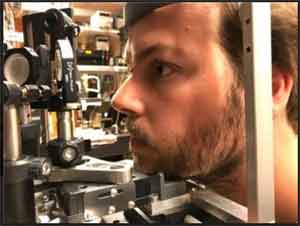- Home
- Editorial
- News
- Practice Guidelines
- Anesthesiology Guidelines
- Cancer Guidelines
- Cardiac Sciences Guidelines
- Critical Care Guidelines
- Dentistry Guidelines
- Dermatology Guidelines
- Diabetes and Endo Guidelines
- Diagnostics Guidelines
- ENT Guidelines
- Featured Practice Guidelines
- Gastroenterology Guidelines
- Geriatrics Guidelines
- Medicine Guidelines
- Nephrology Guidelines
- Neurosciences Guidelines
- Obs and Gynae Guidelines
- Ophthalmology Guidelines
- Orthopaedics Guidelines
- Paediatrics Guidelines
- Psychiatry Guidelines
- Pulmonology Guidelines
- Radiology Guidelines
- Surgery Guidelines
- Urology Guidelines
New OCT technique provides better 3D imaging of the cellular structure of the eye

Optical Coherence Tomography (OCT) is a high-resolution live imaging technique that can be used for early detection of retinal diseases, such as age-related macular degeneration , diabetes-related conditions, glaucoma or vascular occlusions, for example. However, in order to obtain cellular resolution of the retina and hence even better results, it has so far been necessary to use expensive adaptive lenses to correct the image aberrations that occur. However, using a new technique developed at MedUni Vienna, so-called Line Field OCT, MedUni Vienna researchers from the Center for Medical Physics and Biomedical Technology have now managed to simplify looking into the cellular processes in the eye to allow even more accurate diagnosis.
Optical Coherence Tomography works in a similar way to ultrasound scanning but is contact free and uses light, producing high-resolution cross-sectional images of biological tissue. This method is also known as "optical biopsy."
The new LF-OCT technology was recently presented in a study published in Optica by PhD student Laurin Ginner, under the supervision of Rainer Leitgeb (Head of the Christian Doppler Laboratory for Innovative Optical Imaging and its Translation into Medicine).
"Our new technique enables us to make digital corrections without the need for expensive hardware-based adaptive lenses. The linear illumination that is used allows very rapid frame rates, which are extremely important for these corrections. This enables us to correct aberrations over the entire three-dimensional volume of the retina," explains Ginner.
Linear illumination functions a bit like a scanner a strip of light "scans" the eye, allowing better images to be produced. In this way it is possible to resolve individual photoreceptors, capillary blood vessels and individual nerve fibres in the same image. It is also possible to refocus, realign and digitally process the image data obtained, in order to provide the doctor with the best possible results for diagnostic purposes.
OCT was jointly developed by the Center for Medical Physics and Biomedical Technology and the Ophthalmology Department of MedUni Vienna and is constantly being refined by Viennese physicists and ophthalmologists. OCT is currently also being used in dermatology for the early detection of skin cancers. However, this new, even more accurate technique could also open are other areas of medical diagnostics for example in surgery or dentistry -- because it allows for more specific, personalised medicine. Says Leitgeb: "This technique can conceivably also be used for diagnosing neurodegenerative diseases. The eye is the "window" into the brain. Our hope is that the higher resolution will help to improve diagnostic accuracy in general." Every year, around 30,000 people undergo OCT examinations at the Department of Ophthalmology at MedUni Vienna, which is the largest department of its kind in Europe.
The new Line Field-OCT technique was developed in the Christian Doppler "OPTRAMED" laboratory at MedUni Vienna. The new technology is soon to be marketed in collaboration with commercial partner Carl Zeiss Meditec. However, a few additional clinical studies are still required before this can be done.

Disclaimer: This site is primarily intended for healthcare professionals. Any content/information on this website does not replace the advice of medical and/or health professionals and should not be construed as medical/diagnostic advice/endorsement or prescription. Use of this site is subject to our terms of use, privacy policy, advertisement policy. © 2020 Minerva Medical Treatment Pvt Ltd